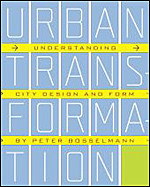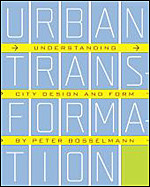How do cities transform over time? And why do some cities change forthe better while others deteriorate? In articulating new ways ofviewing urban areas and how they develop over time, Peter Bosselmannoffers a stimulating guidebook for students and professionals engagedin urban design, planning, and architecture. By looking throughBosselmann’s eyes (aided by his analysis of numerous color photosand illustrations) readers will learn to “see” citiesanew.
Bosselmann organizes the book around seven “activities”:comparing, observing, transforming, measuring, defining, modeling, andinterpreting. He introduces readers to his way of seeing by comparingsatellite-produced “maps” of the world’s twentylargest cities. With Bosselmann’s guidance, we begin tounderstand the key elements of urban design. Using Copenhagen, Denmark,as an example, he teaches us to observe without prejudice or bias. Hedemonstrates how cities transform by introducing the idea of“urban morphology” through an examination of more than acentury of transformations in downtown Oakland, California. We learnhow to measure quality-of-life parameters that are often consideredun-measurable, including “vitality,”“livability,” and “belonging.” Utilizing thestreet grids of San Francisco as examples, Bosselmann explains how todefine urban spaces. Modeling, he reveals, is not so much aboutcreating models as it is about bringing others into public, democraticdiscussions. Finally, we find out how to interpret essential aspects of“life and place” by evaluating aerial images of the SanFrancisco Bay Area taken in 1962 and those taken forty-three yearslater.
Bosselmann has a unique understanding of cities and how they“work.” His hope is that, with the fresh vision he offers,readers will be empowered to offer inventive new solutions to familiarurban problems.Introduction
Chapter1 To compare: Cities- Size, Scale and Form
Chapter2 To observe: Some Observations of Copenhagen's City Form at the Timeof Global Change
Chapter3 To measure: Vitality, Livability and Sense of Place
Chapter4 To transform: Rebuilding the Structure of the Inner City
Chapter5 To define: Urban Design Principles for City Streets
Chapter6 To model: Authenticity, Modeling, and Entitlement
Chapter7 To interpret: A Canvas for an Emerging Commons
Conclusion Principles of Precedent





